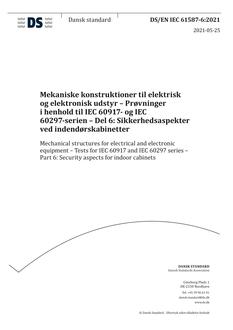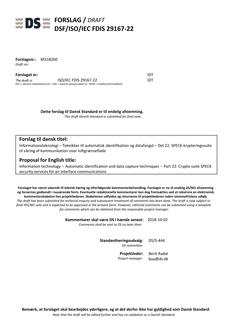-
-
Available Formats
- Availability
- Priced From ( in USD )
-
Available Formats
-
- Immediate download
- $59.00
- Add to Cart
-
- Printed Edition
- Ships in 1-2 business days
- $59.00
- Add to Cart
Customers Who Bought This Also Bought
-

DANSK DS/EN ISO 10993-23
Priced From $110.00 -

DANSK DS/EN IEC 61587-6
Priced From $64.00 -

DANSK DS/EN 50696
Priced From $110.00 -

DANSK DSF/ISO/IEC FDIS 29167-22
Priced From $49.00
About This Item
Full Description
This document explains the requirements and test methods for paraffinic diesel fuel from synthesis or hydrotreatment. Synthesis refers to XTL processes where X refers to various feedstocks for example Gas (G), Biomass (B) or Coal (C) and TL stands for To-Liquid. Hydrotreatment of vegetable oils and animal fats yield Hydrotreated Vegetable Oil (HVO). Paraffinic diesel fuel can be blended with up to 7,0 % (V/V) fatty acid methyl ester (FAME). It provides background information to the final text of EN 15940 [1] and gives guidance and explanations to the producers, blenders, marketers and users of paraffinic automotive diesel. Paraffinic diesel fuel is a high quality, clean burning fuel with virtually no sulfur and aromatics. Paraffinic diesel fuel can be used in diesel engines, also to reduce regulated emissions. In order to have the greatest possible emissions reduction, a specific calibration is needed. Some types of paraffinic diesel fuel, at present notably HVO, can also offer a meaningful contribution to the target of increased non-crude derived and/or renewable content in transportation fuel pool. For general diesel engine operation, durability and warranty, paraffinic automotive diesel fuel needs a validation step to confirm the compatibility of the fuel with the vehicle, which for some existing engines still needs to be done. The vehicle manufacturer needs to be consulted before use. NOTE 1 – This document is directly related to EN 15940 and will be updated once further publications take place. NOTE 2 – Paraffinic diesel fuel is also used as a blending component in automotive diesel fuel. In that case, composition and properties of the final blends are defined by relevant fuel specification standards. NOTE 3 – For the purposes of this document, the terms "% (m/m)" and "% (V/V)" are used to represent respectively the mass fraction and the volume fraction.





